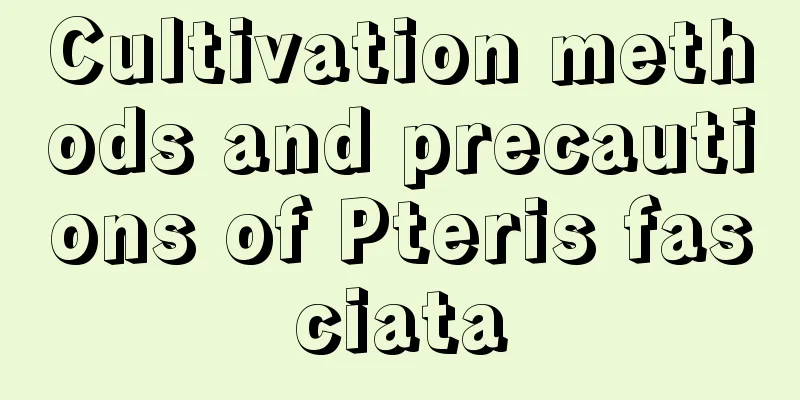Cultivation methods and precautions of Pteris fasciata

How to grow Pteris fernPot soilThe phoenix fern is highly adaptable and has low requirements for soil, but fertile and well-drained soil is preferred, and soil with a high calcium content is best. For potted plants, you can choose plastic pots with strong water retention, and use a substrate mixed with peat soil and garden soil. Broken bricks can be placed at the bottom of the pot as a drainage layer. Light and humidity managementThe phoenix fern likes a semi-shady environment and should avoid direct sunlight. Scattered light is preferred. The growth of phoenix fern requires higher humidity and is not resistant to dryness, so it needs to be sprayed with water frequently to maintain humidity. Too much light will cause the leaves of the fern to shrink and wilt, while insufficient humidity will cause the leaves of the fern to turn yellow. Therefore, it is necessary to manage light and humidity well. Temperature requirementsThe phoenix fern prefers a warm growing environment and requires a growth temperature between 16℃ and 28℃. The wintering temperature cannot be lower than 5℃. It needs to be kept warm and placed in a warm room. In summer, the purpose of cooling can be achieved by providing shade, increasing ventilation, and spraying water. Water and fertilizer managementThe phoenix fern likes moisture, but is afraid of waterlogging, so it is better to water it to make the soil in the pot moist. During the growth period, water frequently, once every 2 to 3 days, and spray water frequently to maintain humidity. In winter, water less and just keep the soil in the pot slightly moist. Fertilization needs to be done thinly and frequently. During the growth period, apply thin liquid fertilizer once every half a month. When repotting, you can apply sufficient base fertilizer. Reproduction methodIt should be noted that the phoenix fern has no flowers and no seeds. It is mainly propagated by division, but it can also be propagated by asexual spores. Precautions for the cultivation of Pteris fernPests and diseasesDuring the growth process of Pteris fern, pests such as aphids and red spiders, as well as root rot may endanger the health of the plant. It is necessary to use pesticides for prevention and control, and do daily management work. Winter yellow leavesWhen the temperature is too low, many yellow leaves will appear on the fern. At this time, be careful not to rush to cut off the yellow leaves of the fern, as the yellow leaves can also transport the nutrients stored in themselves to the new leaves.
|
<<: Cultivation methods and precautions of lotus leaf peperomia
>>: Cultivation methods and precautions of Linaloa
Recommend
How many days is the growing period of cabbage?
The cabbage grows from the inside out, as the out...
Can rice washing water be used to water garlic? The correct way to water rice washing water
Watering garlic with rice water Rice washing wate...
Indoor Plants That Don't Need Sunlight
1. Pothos The green radish has a strong ability t...
How long does it take for a newly planted bougainvillea to bloom (how long does it take for bougainvillea to bloom)
How long does it take for bougainvillea to bloom?...
How much can you earn from growing loofah per acre?
The nutritional value of loofah is very rich, bec...
Can yew be grown indoors?
1. Can be raised indoors Yew can be grown indoors...
When is the best time to plant autumn cowpea?
Cowpea is also called rice bean, string bean , lo...
What are the cultivation methods and precautions of Phalaenopsis orchids?
Phalaenopsis cultivation method Phalaenopsis pref...
How to plant azalea seedlings to achieve a high survival rate, and what is the appropriate spacing between seedlings?
1. How to plant 1. Time: If you want the azalea s...
What to do if white-veined peperomia leaves fall off
1. Normal situation Reason: If the white-veined p...
Brussels sprouts cultivation methods and precautions
1. Maintenance methods 1. Temperature: The most s...
How to grow green radish in winter
In fact, the green ivy is not a plant that require...
How often should you water your calla lilies?
How often should you water your calla lilies? Gen...
How to sow Gloxinia
Variety selection If you want Gloxinia to bloom m...
It only took her 1,000 days to transform the shabby chicken coop into a garden wonderland, and everyone in the village was envious!
Chicken coop becomes garden Looking at the garden...









